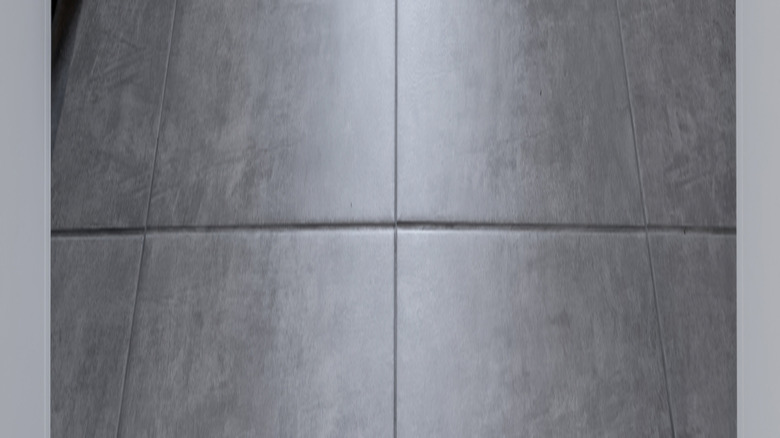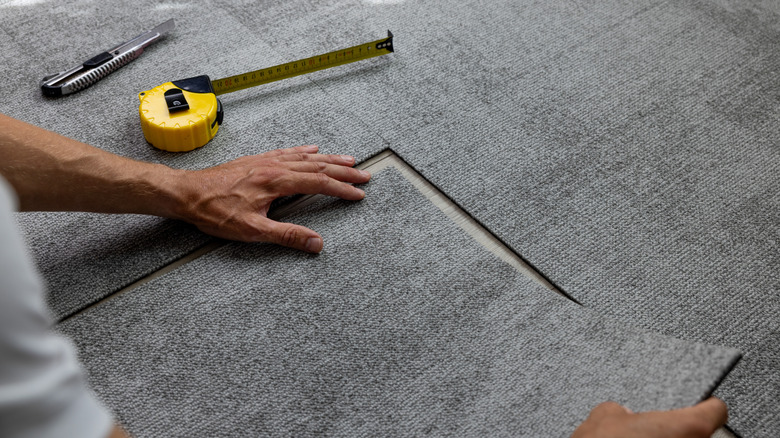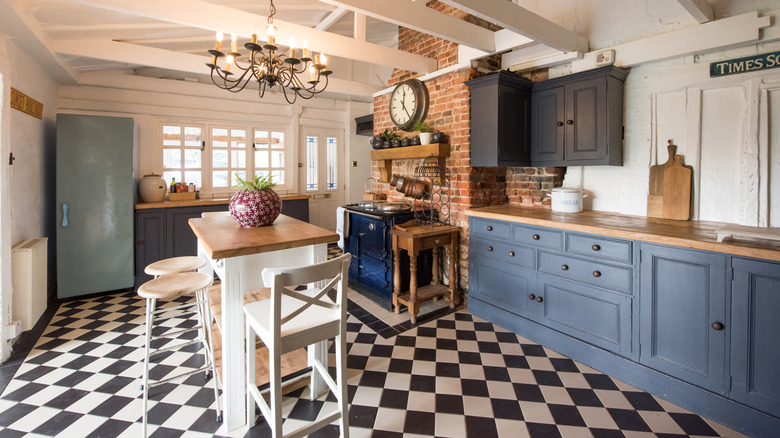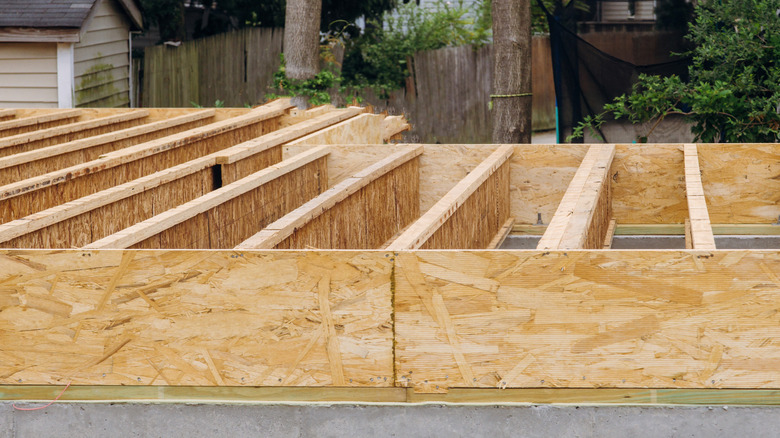Mike Holmes Shares His Expert Advice For Installing The Ideal Flooring In Your Home
We may receive a commission on purchases made from links.
Mike Holmes knows a thing or two about the ideal type of flooring. The Canadian contractor has been fixing other renovators' mistakes for decades and is very vocal about how to do things right — the first time. According to Holmes, the real key to a successful flooring installation is planning ahead and working from the bottom up. That is, removing the old flooring, sprucing up your joists and subfloor, and then installing new flooring that is best suited to that part of the house. What works in the living room may not cut it for the entryway and vice versa, and Holmes has shared this.
Whether your decades-old floors are squeaking and you want them silenced for good, or you are looking for a way to keep your kid's playroom floor both cushioned and clean, Holmes has you covered. His flooring advice covers DIY projects, what materials are best, and when to call in a professional to make sure you get optimal results.
Start by choosing the ideal type of subflooring for a solid foundation
The best floor installation starts with controlling what happens underneath it. "I'm a big fan of subfloors and I have been for many years because they serve a lot of purposes," Holmes said on YouTube. While the subfloor acts like a foundation for a room, it's different than the actual foundation of your house. Instead, it's the structural layer of flooring that sits directly on top of the base of the floor and beneath the visible flooring (like hardwood or carpet, etc.). It provides stability and support to the finished floor as well as other key benefits like temperature and moisture control.
It needs to be strong and level for the rest of your flooring installation to be successful. A material Holmes likes using to accomplish this is Amdry Insulated Subfloor Panels. "This product, I got to tell you now, I've been looking and paying attention, and [it's] a product that makes total sense to me," he continued in the video. "By laying this on the floor, what we're doing is thermally breaking through the bottom." These panels also help regulate the temperature and moisture levels under the subfloor, which can prevent mold from growing, as well as the floor from cracking and warping. Avoiding these things can save you plenty of money on costly floor repairs down the line.
Plan ahead and level the existing flooring before installing anything new
Before you install a new floor, Holmes warns that you can't skip leveling the existing floor. "In over 30 years of experience, I gotta tell you, I've seen a lot of bad tiling jobs, and it's usually because nobody tends to level the floor first," he shared about a recent project on YouTube. Leveling the floor means making the surface of a floor uniform in height across the entire area. If you do this before laying down new work, you can avoid problems like cracks in the material, dips in the floor, and wood warping. "The dips in the floor, that's unacceptable. Any time you're going to tile, you want it to be 100% level," he continued, speaking of the problems he needed to fix during the episode.
Holmes recommends using a self-leveling compound to make things easy, no matter your skill level. First, clean up the project zone to make sure there isn't any debris on the floor left over from the demolition of the prior floor. Next, mix the formula depending on the instructions on the bag. Holmes is using a Sika product, similar to the High Strength High-Flow Floor Leveler, for this project. Once mixed up, you can pour it slowly onto the floor. Start at the point furthest from the door and work towards it so you don't get stuck. From there, it'll typically be about 48 hours before it's dried and ready for the next step (your new floor!).
Install tile in your entryways if you live where it snows
Getting the flooring for your entryway right is essential for the success of the rest of your home. It's not just about fashion, but function, too, especially if you live somewhere with a harsh winter climate. "I'm not against tile and I actually like it, especially when it comes with in-floor heating," Holmes told HGTV Canada. "For instance, you'll definitely want tile over carpet for the entrance of your home and the mudroom. When you and your family wear winter boots, you don't want them staining carpets." As snow melts, it's easier to wipe it off the surface of tile, rather than constantly dealing with the smell of wet carpet and the potential for mold and mildew.
Holmes warns that there is another flooring choice that's even worse if you live up north because of the potential for trekked-in mud and snow. "Never put hardwood floors right at the front door, as you can ruin the wood when you bring in moisture from outside," he continued. For this reason, tiling is always the way to go. If you worry about it being too cold underfoot, you can use in-floor heating, as Holmes suggests. He works with Schluter-Systems and recommends the DITRA-HEAT (120V) Floor Heat Kit. In addition, just because your entry points are tiled, it doesn't mean you can't have carpeting or another flooring of your choice in another area of your house if you'd like.
If you have kids, installing carpet tiles is ideal for their spaces
When thinking of an ideal flooring option for children's spaces, Holmes makes it clear that you should go for carpet. "Consider hypoallergenic carpeting for your kid's playroom," he told HGTV Canada. His suggestion for the ideal flooring choice for young families might seem a bit rogue to some, as carpet can be tough to keep clean. However, he has the reasoning to back it up, explaining, "And although carpeting isn't typically spill-friendly, there are carpet tiles that come in all sorts of designs and colors, so if a spill does happen, the carpet tile can be removed and replaced."
Carpet tiles, sometimes called carpet squares, make it easy to keep things fresh, and can easily be installed over hardwood floors or LVP. That means that you can easily remove them to transform the space into something else when the kids grow up, without paying to redo your floors again. There is also lots of room for creativity when using carpet tiles, as you can mix or match colors and patterns to suit your vision for the room. If you want to keep things uniform, you might purchase a few extra tiles at the beginning to ensure you have matching options on hand if any are ruined later on. Just make sure to store them somewhere climate-controlled, like a closet in a finished basement, instead of the garage or attic, so they don't grow mold or start to stink.
The ideal choice for kitchen flooring is ceramic tiles
Getting the flooring right for your kitchen can be tough, since it's both a high-use space and one that can get really wet. Plenty of much-loved materials, like hardwood and carpet, can struggle to hold up to both of these. Instead, Holmes thinks the ideal choice is something that can."Ceramic and porcelain tiles are my recommendation for kitchen floors," he wrote for Make It Right. "They are durable, attractive, easy to clean, and available in a large variety of patterns and finishes."
His reasoning hinges on tile flooring being easy to keep clean in such a chaotic environment. "With proper installation, ceramic tiles are the IDEAL choice for a kitchen that has access to the outdoors," he continued. "This is because tile can handle the moisture and dirt that is bound to come in." Not only that, but Holmes also confirms that glazed ceramic tiles in particular are resistant to stains. However, he points out that scratches in glazed tiles might be visible. However, if you do scratch up the floor, something like Rejuvenate All Floors Restorer can help disguise minor blemishes.
If you need an accessible home, thin carpet and laminate will be ideal
If you're reflooring your house with accessibility in mind, Holmes recommends either a thinner carpet or laminate for the best results. This applies if it's for a family member who needs it now, or if this is your forever home and you want to prepare it for future needs as you age. "You might think that carpet can be a hindrance to someone using a wheelchair, but if you plan for it, it can work," he shared on Make It Right. "A thinner carpet, with a pile or height of half an inch or less, without an underpad, will offer far less resistance and accommodate accessibility devices easily." This is because the wheels on a wheelchair, or the bottom of a walker, might not glide as smoothly over plush carpet, making mobility difficult. With a thinner option, you remove this obstacle, while still retaining the underfoot comfort of carpet.
Yet if you prefer not to deal with carpet at all, you can also choose laminate. "Laminate can mimic the look of wood, but it offers better durability and resistance than some softer woods," he continued. "Laminate flooring is also a good option for cost-conscious homeowners." Most mobility devices can glide across laminate quite easily, making its inclusion an easy way to increase the accessibility of your home.
There is only one correct choice for basement flooring: Tile
Basements can be cold and damp, making nailing the ideal flooring type difficult. Yet Holmes warns that you should start out by just staying away from certain materials. "I don't think people realize that tiles should be the number one product you put in your basement," he said in a Facebook video. "Wood, linoleum, carpet — these are a lot of things people put in the basement. You're gonna be taking that out." His reasoning is that they aren't waterproof enough and will make for a miserable experience at a sub-ground level.
Instead, he recommends sticking with tiling in basements. "Tiles? Not only is it easy to keep clean, dry, watertight — this is what I call a long-term solution." If you are worried about tile being too cold underfoot, Holmes recommends adding the Schluter®-DITRA-HEAT-DUO to solve this problem. This combination ensures that your basement will be cozy when needed, but it won't suffer from that damp and musty stink that can be so difficult to get rid of, as everything will be nice and dry.
Install your floor joists with the right amount of spacing to avoid squeaks later on
The key to a squeak-free floor is all about the ideal installation. The choices you make early on can impact whether you have to do expensive repairs or live with annoying sounds, in the future. "The squeaks and creaks problem could also be related to your floor joists," Holmes wrote for his blog, Make It Right, about the frustration of a squeaky floor. Floor joists are the horizontal supports that form the framework beneath floors, helping hold up the subfloor and everything on top of it. Its job is to distribute weight evenly to keep the floor strong and level.
So, if they aren't built correctly, problems will follow. "It could be that they've been spaced too far apart, or they haven't been properly blocked," Holmes continued. "Blocking between your joists adds stiffness, preventing them from moving, which means fewer squeaks in your finished floor." Joist blocks are small pieces of wood or metal placed between the beams, making the joists look a bit more like honeycomb, rather than a ladder. If you can't install them during installation, all hope is not lost. "If you have access to the joists from below (like in an unfinished basement), you can add more blocking — assuming there aren't any ducts or wiring in the way," Holmes suggested.
Bathroom flooring needs to be waterproof for it to be ideal
You must be very careful when choosing the materials to renovate your bathroom floor, as this room is likely the wettest space in your house. Because of this, take extra care to choose waterproof materials. Tile is often a popular choice because it is water resistant, but Holmes recommends going the extra mile. "By waterproofing your bathroom, you prevent water from penetrating vulnerable areas like the walls, floors, and joints. This protects against rotting wood, rusting metal, and peeling paint," he wrote on Make it Right. "Additionally, waterproofing helps maintain a clean and dry environment, reducing the need for costly repairs in the future."
So, is installing tile enough? Not really, Holmes warned. Instead, using under-floor options that actually make your bathroom waterproof is the only way to guarantee results. Plus, these allow for an upgrade that Holmes says will upgrade your bathroom — heated floors. "Schluter-DITRA and DITRA-HEAT are game changers. These uncoupling membranes provide waterproofing and floor protection, including preventing cracked tiles and grout lines, while also allowing for the installation of in-floor heating systems," he continued. You can purchase Schluter Systems directly from the supplier. They must be installed once the current floor is removed, so this is a change you can only make during renovations.
If you have a high-traffic home, busy grains are ideal for hardwood
Hardwood floors are often the right choice for a home thanks to their timelessness. However, Holmes insists that certain types of wood are best for different living situations. For the floors to truly be ideal, you have to choose carefully. "If you have the kind of home where dogs or cats are running around, people are always coming through or kids bring their friends over to play, then you want a busy grain," he told The Free Press. "A busier, grainier hardwood helps hide scratches."
So, which woods should you consider? Holmes shared that oak, hickory, and ash typically have more intricate patterns, making them best for this purpose. Yet pattern isn't the only thing to consider if you like to hide your household's busyness. You also need to think about the wood's hue, too. "Lighter and more natural colors are also better options if you're worried about scratches, which darker stains really highlight," Holmes continued. That is, a light-colored scratch stands out sharply against a dark background when the reverse isn't as true. Finally, for an easy choice that takes both suggestions into account, Holmes recommended low-maintenance red oak. "It will look great for years — even with a million scratches — because of its grain," he said.
Even if you love tile, it's not ideal to install tile on top of tile
As mentioned, Holmes thinks tile is an ideal choice for flooring in many parts of the home. However, if you already have tile and are thinking of updating it, you cannot skip the most important step if you want to be successful — demolition day! Holmes is adamant that tile on top of tile is a recipe for disaster. "Some homeowners and contractors think you can lay your new tile directly over your existing tile to save some time," he shared on Instagram. "Why do I hate this? Well, for one thing, you're just asking for your new tile and grout to crack. So, that brand new floor isn't going to keep its look for very long."
The reasoning here is simple. Old tile may have some uneven spots, loose sections, or even compromised adhesive. Laying new tile over this creates weak points that can't handle pressure or movement properly, leading to cracks in the new layer as soon as you put any weight on it. Yet this isn't the only problem! Holmes also recommends that when changing out flooring, it's always a good idea to have a look at what's underneath. This way, you can solve problems before they ripple out and become way more expensive. "But the bigger issue is that without tearing up the existing floor, you can't properly judge the state of the underlay," he continued. "Tear up the old, assess the state of the subfloor, and fix what needs fixing."







